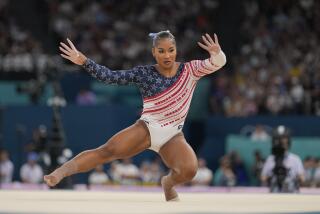A New Day in Skating Scoring
- Share via
Figure skating’s new cumulative scoring system, conceived in response to the judging scandal that undermined the sport’s credibility at the Salt Lake City Olympics, will take its next leap toward acceptance today at Skate America, the season’s first International Skating Union Grand Prix event.
The system gives judges more criteria to evaluate performances and minimizes opportunities for bloc voting.
French judge Marie-Reine LeGougne’s claim that she had been pressured to vote for a Russian pair over a Canadian duo at the 2002 Olympics led to the awarding of duplicate gold medals for the Canadians and an overhaul of the scoring and judging process.
The new system was tested last season in Grand Prix events and refined before it was approved for use at all ISU championship events this season. It will be in effect at the 2006 Turin Olympics.
Each national federation can choose whether to adopt it for domestic events this season. U.S. Figure Skating will not implement it at the 2005 national championships but is expected to adopt it at a governing council meeting in May.
U.S. officials said the system didn’t include sufficient accountability for judges, but their proposal to display judges’ scores and names was defeated at an ISU meeting this year. The ISU will experiment with listing judges’ names at Junior Grand Prix events this season, and judges at ISU championship and Grand Prix events will be subject to review by an ISU commission.
“After testing it, and getting feedback from our athletes and coaches, we became supporters,” said Chuck Foster, president of U.S. Figure Skating. “The one thing we wanted was transparency, which they are doing in the Junior Grand Prix.
“If we adopt it in this country, we can adjust it any way we want, and we will. ... It is our hope that it will be passed, even though it’s still sort of a work in progress.”
The new system rewards skaters for technical proficiency and artistry. Judges award points to each competitor or duo based on the performance, rather than devising marks that place the competitors in relation to one another.
Judges also need not hold back points from a skater who performs well early in the starting order. In the past, judges kept marks low for the first few skaters to reserve higher placements for subsequent skaters who might dazzle them. Without such artificial limits, skaters rose or plunged in the standings in the final part of the competition during last season’s tests, adding drama.
Each skater or duo will get a technical score as well as scores for skating skills, transitions/linking footwork and movements, performance/execution, choreography/composition, and interpretation. Each jump has been assigned a value, such as 5.5 for a triple flip and 9.5 for a quadruple salchow, and judges can add or subtract points based on the quality of its execution.
Nine judges’ scores will be randomly chosen from each 12-judge panel and added to determine the score.
“What I really love about this system is it takes the emphasis off jumping and more on overall skating,” said world silver medalist Sasha Cohen, who planned to compete at Skate America until back pain led her to withdraw this week. “It gives me a chance to be a little more creative.”
More to Read
Go beyond the scoreboard
Get the latest on L.A.'s teams in the daily Sports Report newsletter.
You may occasionally receive promotional content from the Los Angeles Times.







